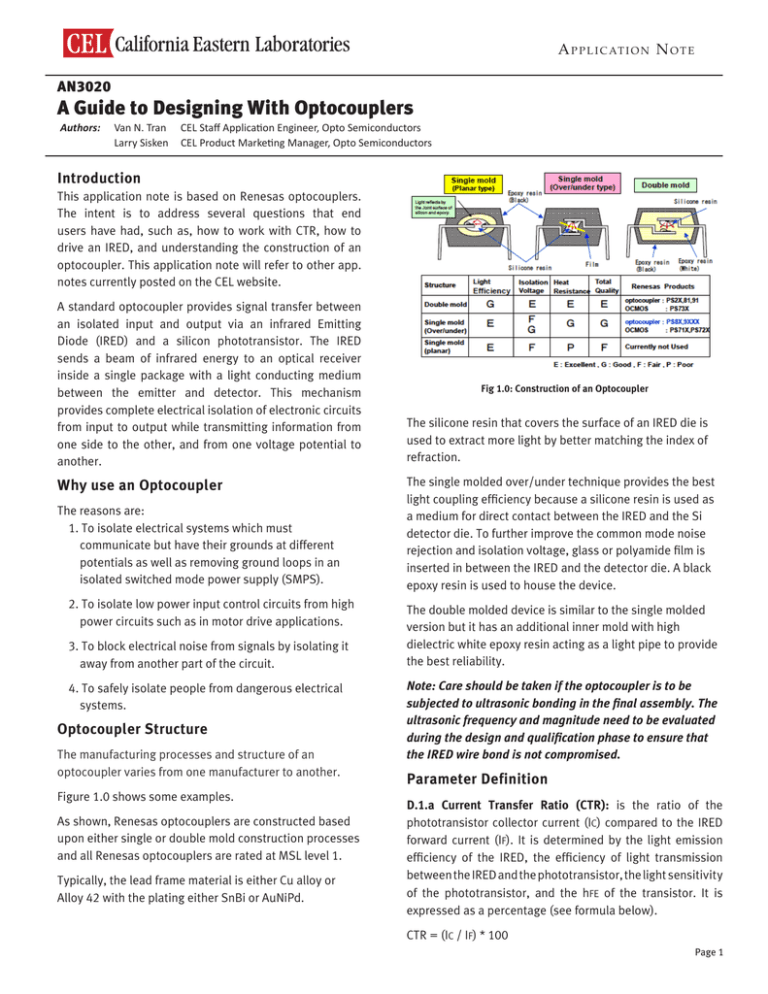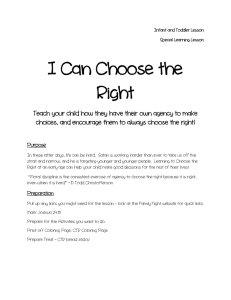A Guide to Designing With Optocouplers
advertisement

A p p l i c at i o n N o t e AN3020 A Guide to Designing With Optocouplers Authors: Van N. Tran CEL Staff Application Engineer, Opto Semiconductors Larry Sisken CEL Product Marketing Manager, Opto Semiconductors Introduction This application note is based on Renesas optocouplers. The intent is to address several questions that end users have had, such as, how to work with CTR, how to drive an IRED, and understanding the construction of an optocoupler. This application note will refer to other app. notes currently posted on the CEL website. A standard optocoupler provides signal transfer between an isolated input and output via an infrared Emitting Diode (IRED) and a silicon phototransistor. The IRED sends a beam of infrared energy to an optical receiver inside a single package with a light conducting medium between the emitter and detector. This mechanism provides complete electrical isolation of electronic circuits from input to output while transmitting information from one side to the other, and from one voltage potential to another. Why use an Optocoupler The reasons are: 1. To isolate electrical systems which must communicate but have their grounds at different potentials as well as removing ground loops in an isolated switched mode power supply (SMPS). 2. To isolate low power input control circuits from high power circuits such as in motor drive applications. 3. To block electrical noise from signals by isolating it away from another part of the circuit. 4. To safely isolate people from dangerous electrical systems. Optocoupler Structure The manufacturing processes and structure of an optocoupler varies from one manufacturer to another. Figure 1.0 shows some examples. As shown, Renesas optocouplers are constructed based upon either single or double mold construction processes and all Renesas optocouplers are rated at MSL level 1. Typically, the lead frame material is either Cu alloy or Alloy 42 with the plating either SnBi or AuNiPd. Fig 1.0: Construction of an Optocoupler The silicone resin that covers the surface of an IRED die is used to extract more light by better matching the index of refraction. The single molded over/under technique provides the best light coupling efficiency because a silicone resin is used as a medium for direct contact between the IRED and the Si detector die. To further improve the common mode noise rejection and isolation voltage, glass or polyamide film is inserted in between the IRED and the detector die. A black epoxy resin is used to house the device. The double molded device is similar to the single molded version but it has an additional inner mold with high dielectric white epoxy resin acting as a light pipe to provide the best reliability. Note: Care should be taken if the optocoupler is to be subjected to ultrasonic bonding in the final assembly. The ultrasonic frequency and magnitude need to be evaluated during the design and qualification phase to ensure that the IRED wire bond is not compromised. Parameter Definition D.1.a Current Transfer Ratio (CTR): is the ratio of the phototransistor collector current (IC) compared to the IRED forward current (IF). It is determined by the light emission efficiency of the IRED, the efficiency of light transmission between the IRED and the phototransistor, the light sensitivity of the phototransistor, and the hFE of the transistor. It is expressed as a percentage (see formula below). CTR = (IC / IF) * 100 Page 1 AN3020 In production, the CTR of an optocoupler is sorted into ranks based upon the light output of the IRED die and the hFE of the phototransistor. Ranks have a minimum and maximum CTR and the range of a rank is usually in a 2:1 ratio. Adjacent ranks normally have their respective CTR range overlapped. Note that the CTR is defined at a given VCE with the phototransistor NOT in saturation and in a common collector configuration as shown in figure 2.0. IF VCC Fig 4.0: CTR vs. Vcc Ic VOUT Rin RL Fig 2.0: Common Collector Amplifier Figure 3.0 shows CTR vs. Forward Current (IF) for the PS2501A-1 at VCE =5.0 V. This CTR graph is based on samples selected from different CTR groupings (high, median, low) as a representative of the whole population for reference. 250 D.1.b CTR vs. Temperature: CTR vs. temperature is greatly affected by the characteristics of light emission efficiency of the IRED and hFE of the phototransistor. IRED efficiency decreases with temperature while transistor hFE increases. This causes a peak in the CTR curve where the hFE becomes the dominant factor at low temperature. The IRED characteristic has a larger affect at high temperature. As a result, the CTR characteristics and its ambient temperature dependency have a typical graph as shown in figure 5.0 below. NORMALIZED CURRENT TRANSFER RATIO vs. AMBIENT TEMPERATURE VCE = 5 V, n=3 200 150 Sample A B C 100 50 0 0.01 0.1 1 10 100 Forward Current IF (mA) Fig 3.0: CTR vs. Forward Current, IF Figure 4.0 is another example showing data collected from different PS2501A-1-A in the common collector topology. It shows how the CTR varies with different Vcc settings for the same load (RL=100Ω) and the same drive condition. Normalized Current Transfer Ratio CTR Current Transfer Ratio CTR (%) 300 CURRENT TRANSFER RATIO vs. FORWARD CURRENT Note: Different manufacturers use different drive conditions when specifying their CTR. One needs to be careful to examine the drive conditions when comparing CTR information in the data sheets from different manufacturers. 1.4 1.2 1.0 0.8 0.6 0.4 0.2 Normalized to 1.0 at TA = 25°C, IF = 5 mA, VCE = 5 V CTR:130% 0 –50 CTR:270% –25 0 25 50 75 100 Ambient Temperature TA (°C) Fig 5.0: CTR vs. Ambient Temperature The CTR is reduced largely as the forward current (IF) increases or as the operating temperature increases. As a result, it is highly recommended to operate the optocoupler within the recommended operating conditions. To understand the Page 2 AN3020 impact of the CTR degradation on the design, please refer to CEL Applications Note AN3004, “How to simulate Current Transfer Ratios (CTR) and long-term CTR degradation in transistor optocouplers” available at: http://www.cel.com/pdf/appnotes/an3004.pdf Also refer to CEL Application Note AN3021, “Renesas/CEL Optocoupler Thermal Calculations” available at: http://www.cel.com/pdf/appnotes/an3021.pdf D.1.c How to estimate the CTR range at different forward currents: To understand this issue, the PS2501A-1-Q-A is used for illustration purposes. Given “Q” rank with CTR=100% to 200% at IF = 5.0mA and VCE=5.0V, how can one estimate the CTR at IF=1.0mA and VCE=5.0 V? D.2 Response Characteristics: The response characteristics of optocouplers are the same as those of phototransistors. The fall time tf is expressed by: tf ≈ RL · hFE · CCB RL: Load resistance hFE: Amplification factor CCB: Collector-base capacitance. Note: In general, the device with lower CTR (smaller hFE) provides the best rise and fall time and frequency response since it requires less base region minority charge and discharge during the turn on and turn off time. Figure 6.0 shows graphs of switching times vs. CTR rank based upon the PS2501A-1-A used in a common collector topology. First, find the CTR @ 1.0mA and the CTR @ 5.0mA for all 3 samples in Figure 3. Then calculate ratios (CTR @ 1.0mA/ CTR @ 5.0mA). These ratios are used to estimate the CTR distribution of the device if it is operated at different forward currents. The ratio of CTR based on sample A ≈ (182%/280%) = 0.65 The ratio of CTR based on sample B ≈ (118%/200%) = 0.59 The ratio of CTR based on sample C ≈ (80%/135%) = 0.59 The estimated CTR band of “Q” rank at IF=1.0mA can be determined by multiplying the lowest ratio of the 3 samples (.59), which in this case is either sample “B” or sample “C” times the low end of the “Q” rank (which is measured at 5mA) of 100% to give us a minimum CTR at 1mA of 59%. To get the upper end of the CTR range multiply the highest ratio of the 3 samples (in this case sample “A” at .65) times the upper end of the “Q” rank (in this 200%). This gives us a value of 130%, so the estimated CTR range at IF = 1.0mA and VCE = 5.0 V for PS2501A-1-Q-A is 59% to 130%. The CTR range is also affected by operating temperature as shown in figure 5.0. Using figure 5.0, one can estimate that the CTR varies from ~1.1 to ~0.6 across the temperature range of -50°C to 100°C, so the PS2501A-1-Q-A has the estimated CTR range at IF=1.0mA from ~65%=(1.1*59%) to ~78%=(0.6*130%) across the temperature range from -50°C to 100°C. Based on the above estimation the end user can design for the worst case at 1mA input. Fig 6.0: Switching time based on different CTRs This topic is covered in three of our existing application notes: 1. Phototransistor Switching Time Analysis (AN3009) 2. Design Guideline for a Renesas/CEL Optocoupler with Transistor Output (AN3010) 3. Renesas/CEL Optocoupler Thermal Calculations (AN3021) Page 3 AN3020 These application notes can be found on the CEL web site at: http://www.cel.com/appnotes. do?command=showByType&group=2 By setting IF=1.0mA, Vcc=5.0V, the Rin=3.9KΩ at Ta=25°C as shown in figure 8.0. VCC=5V D.3.a How to drive an IRED at a given forward current: The parameters of interests are the forward current (If), forward voltage (VF), and ambient temperature (Ta). This section explores how these parameters come together. The PS2911-1-A is used as an example. D.3.b Forward Voltage vs. temperature at a given current: Based on the information from the PS2911-1-A data sheet, the forward voltage has a range from 0.9V to 1.3V with 1.1V as a typical value @ IF=1.0mA. IF=1.0mA VCC=5V IF=0.92mA 3.9V Rin= 3.9KOhm LED Diode Forward Voltage LED from Photocoupler Fig 8.0: IRED Driver at Ta = 25°C VF=1.42V LED from Photocoupler Fig 9.0: IRED Driver at Ta = -50°C At Ta=-50°C, VF=1.42V, IF=0.92mA as shown in figure 9.0. VCC=5V Symbol Conditions MIN TYP MAX Unit VF IF=1 mA 0.9 1.1 1.3 V IF=1.08mA 4.23V Rin= 3.9KOhm LED The graph in figure 7.0 provides ΔVF over the temperature range from -50°C to 100°C. FORWARD CURRENT vs. FORWARD VOLTAGE VF=0.77V LED from Photocoupler 100 Forward Current IF (mA) LED VF=1.1V Electrical Characteristics (TA=25°C) Parameter 3.58V Rin= 3.9KOhm Fig 10.0: IRED Driver at Ta = 100°C At Ta=100°C, VF=0.77V, IF=1.08mA as shown in figure 10.0 10 TA = +100°C +60°C +25°C 1 In summary, the forward current IF varies from 0.92mA to 1.08mA @ Ta=-50°C to 100°C 0°C –25°C –50°C 0.1 0.01 0.0 0.5 1.0 1.5 Observation: The IRED forward voltage has a negative coefficient with respect to operating temperature increases. 2.0 Forward Voltage VF (V) ΔVF=0.13V ΔVF=0.12V Fig 7.0: Forward Voltage Variation over Temp. The ΔVF from 25°C to 100°C is ~-0.13V and from 25°C to -50°C ~0.12V. For the worst case analysis: VF=0.9V – 0.13V=0.77V @ Ta=100°C and VF=1.3V + 0.12V=1.42V@ Ta =-50°C As a result, VF varies from 1.42V to 0.77V at IF=1.0mA across the ambient temperature range, Ta=-50°C to 100°C Information and data presented here is subject to change without notice. California Eastern Laboratories assumes no responsibility for the use of any circuits described herein and makes no representations or warranties, expressed or implied, that such circuits are free from patent infringement. © California Eastern Laboratories 07/15/15 The above examples should enable designers to figure out the IRED current and the affected CTR range over a given operating temperature range for any application. For information on Thermal Calculations please refer to application note AN3021. Conclusion This application note uses the PS2501A-1-A and PS29111-A as examples and it also refers to other application notes, such as, AN3004, AN3009, AN3010, and AN3021 to provide engineers with the necessary knowledge to design with optocouplers in their applications as the most cost-effective solution for isolation purpose and with high reliability. 4590 Patrick Henry Drive, Santa Clara, CA 95054-1817 Tel. 408-919-2500 FAX 408-988-0279 www.cel.com Page 4




